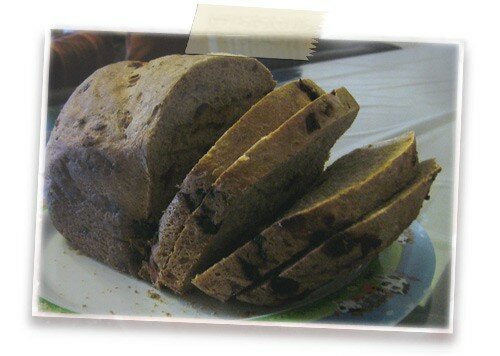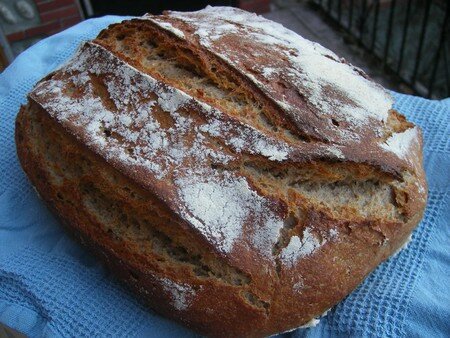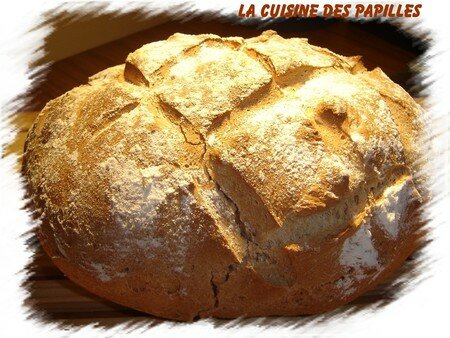Depuis quelque temps, je teste et j’invente différentes recettes avec de la farine de seigle. J’avais déjà boulangé avec cette farine, mais quand j’ai commencé à faire le Pierre Nury’s rustic rye (recette ICI) c’était une révélation. La retardation toute la nuit fait sortir un parfum et un goût uniques qui m’a complètement séduite. Au point que si je n’en aie pas pour le petit-déjeuner, je suis malheureuse.
J’ai décidé de faire une série de billets sur les différents pains au seigle que je confectionne.
For some time now I have been testing and inventing different recipes that use rye flour. I had already made bread with rye, but when I started making Pierre Nury’s rustic rye (here), it was a veritable revelation. The over night cold retarding develop a unique smell and a taste that
I fell in love with. To the point that if I don’t have my rye bread for
breakfast, I’m very unhappy!
So, I’ve decided to do a series of posts on different rye breads that I have tested recently.
Pour commencer, je vous présente une version de la recette de baguettes au levain, basée sur la technique d’Anis Bouabsa, que j’avais publiée (ICI). À l’origine, ma Grande Quête de la Baguette a démarré dans le site The Fresh Loaf avec David, un autre passionné de la boulange. Lui aussi cherchait une recette de baguette qui pourrait lui combler.
Mes aventures avec la farine de seigle a aussi commencé avec lui car c’est grâce à ses billets sur le Nury’s rye que j’ai découvert ce pain.
Alors pour nous deux, la suite logique de la baguette était d’y rajouter un peu de seigle dans la pâte. Moi, j’ai fait des baguettes classiques:
To start with, I wanted to present a version of the sourdough baguettes I have been making (here). The Great Baguette Quest started at The Fresh Loaf with David, another at home baker. He also was looking for the perfect baguette recipe.
My adventures with rye flour started with him when he presented the Pierre Nury’s light rye.
So, for us, both rye fans, adding rye to the sourdough baguette recipe seemed rather logical. I started out by just adding some rye to the initial recipe and came up with this:

Lui, il en a fait une sorte de pain de campagne au levain en forme de bâtard:
He made a style of sourdough pain de campagne in the form of a bâtard:


On a trouvé ce pain vraiment extra ! Il y a juste assez de seigle pour donner une saveur plus complexe et la mie reste bien aérée, la croûte croustillante (à la sortie du four).
We both found this bread very good! There is just enough rye to develop a more complex flavor while keeping a very open crumb and a crunchy crust (fresh out of the oven).
David Snyder’s Pain de Campagne
La version anglaise est celle qu’il a écrite. Je ne l’ai pas modifiée.
The English version is David’s writing, I didn’t modify anything.
Formula/Formule
100 g levain actif (100% hydratation) ripe starter
450 g farine T65 (French style flour or a blend to get around 11 -11,5 % protein)
50 g farine de seigle complete (Guisto’s rye flour)
370 g eau (water)
¼ cc levure de boulanger ( ¼ tsp instant yeast)
10 g sel (salt)
Mixing/Pétrissage
Dans un grand bol, mélanger le levain avec l’eau pour le dissoudre. Ajoutez les farines et mélangez. Couvrez et laisser reposer (l’autolyse) 20 min.
Parsemez la levure sur la pâte et mélangez avec une Maryse ou une spatule en plastique. Parsemez le sel et mélangez encore.
Prenez la Maryse et poussez-la sous la pâte sur un côté. Soulevez le bord de la pâte et pliez-la vers le milieu en haut. Tournez le bol 1/5 tour et refaites le même geste. Continuez 20 fois ce qui fait 4 tours du bol. Recouvrez le bol et laissez reposer 20 min. Refaites les plis encore 20 fois, recouvrez le bol et laissez reposer 20 min. Refaites encore 20 plis.
In a large bowl, mix the active starter with the water to dissolve it. Add the flours and stir to form a shaggy mass. Cover tightly and let rest (autolyse) for 20 minutes.
Sprinkle the yeast over the dough and mix with a plastic scraper. Then sprinkle the salt over the dough and mix.
Using the plastic scraper, stretch and fold the dough 20 times, rotating the bowl 1/5 turn between each stroke. Cover tightly. Repeat this stretch and fold procedure 20 minutes later and, again, after another 20 minutes.
Fermentation/Première fermentation
Après la troisième série de plis, à l’aide de la Maryse, versez la pâte dans un grand bol légèrement huilé et couvrez bien. Placez immédiatement au frigo et laissez-le 21 heures. Aprsè cette durée la pâte aura doublé et sera pleine de bulles.
After the third series of stretches and folds, scape the dough into a lightly oiled 2 quart/2 liter container and cover tightly. (I use a 2 quart glass measuring pitcher with a tightly fitting plastic lid manufactured by Anchor Glass.) Immediately place in the refrigerator and leave it there for 21 hours. (In this time, my dough doubles in volume and is full of bubbles. YMMV.)
Dividing and Shaping/Division et formation
(Il a choisi de faire un gros bâtard, mais vous pouvez faire deux bâtards ou des baguettes. J’en fais 4 – 5 petits à cause de mon four français, bien plus petit que les fours Américains !)
Sortez la pâte du frigo et sortez la pâte du bol avec l’aide de la Maryse pour ne pas la déchirer. Avez vos mains, pressez délicatement sur la pâte pour formez un rectangle. Pour effectuer une première mise en forme, prenez le bord opposé et pliez-le vers le milieu en dépassant un peu. Sellez-le en appuyant avec le bord externe de l’auriculaire (petit doigt). Prenez le bord plus près de vous et pliez-le vers le milieu, juste au-dessus le premier pli.
Couvrez la pâte et laissez repose 30-60 min. (selon la température ambiante et l’activité du levain. La pâte va lever mais juste un peu.
Formez le bâtard. Pour cela, prenez le bord plus près de vous et pliez-le vers le milieu et sellez-le comme avant. Maintenant prenez le bord opposé et pliez-le jusqu’au bord de la pâte pour l’enfermer complètement. Sellez-le. Roulez la pâte pour que la fermeture soit cachée sous la pâte, et puis roulez tout doucement pour sellez la fermeture encore plus. Avec les paumes posées doucement sur la pâte roulez la pâte pour former un boudin en éloignant les deux mains de plus en plus et en mettant plus de pressions vers les extrémités pour former un bâtard.
(I chose to make one very large bâtard, but you could divide the dough into 2 or 3 pieces and make smaller bâtards, boules or baguettes. Or, you could just cut the dough and not shape it further to make pains rustiques.)
Take the dough out of the refrigerator and scrape it gently onto a lightly floured work surface. Gently pat it into a rectangle. To pre-shape for a bâtard, fold the near edge up just past the center of the dough and seal the edge by gently pressing the two layers together with the ulnar (little finger) edge of your hand or the heel of your hand, whichever works best for you. Then, bring the far edge of the dough gently just over the sealed edge and seal the new seam as described.
Cover the dough with plastic wrap and/or a kitchen towel and let it rest for 30-60 minutes, with the seams facing up. (The time will depend on ambient temperature and how active your starter is. The dough should have risen slightly, but not much.)
To shape a bâtard, fold the near edge of the dough and seal the edge, as before. Now, take the far edge of the dough and bring it towards you all the way to the work surface and seal the seam with the heel of your hand. Rotate the loaf gently toward you 1/4 turn so the last seam you formed is against the work surface and roll the loaf back and forth, with minimal downward pressure, to further seal the seam. Then, with the palms of both hands resting softly on the loaf, roll it back and forth to shape a bâtard. Start with both hands in the middle of the loaf and move them outward as you roll the loaf, slightly increasing the pressure as you move outward, so the bâtard ends up with the middle highest and the ends pointed .
Preheating the oven/Préchauffage
Avec la pierre à pain et la lèchefrite en place et un autre récipient métallique posé dedans, préchauffez le four à 250°C. Pensez à le faire au bon moment par rapport à la levée de la pâte, à peu près 15 min après la première mise en forme de la pâte.
Place a baking stone on the middle rack and both a cast iron skillet and a metal loaf pan (or equivalent receptacles of your choosing) on the bottom shelf. Heat the oven to 500F. (I like to pre-heat the baking stone for an hour. I think I get better oven spring. Since I expected a 30 minute rest after pre-shaping and a 45 minute proofing, I turned on the oven 15 minutes after I had pre-shaped the loaf.) I put a kettle of water to boil 10 minutes before baking.
Proofing/Deuxième fermentation
Posez le pâton dans une couche, ou sur une plaque farinée et retournée. Couvrez le pâton avec un torchon. Laissez lever à peu près 30 min. Le pâton doit gonfler à peu près 1 ½ fois. Ne le laissez pas trop lever car vous voulez une bonne augmentation du volume au four.
After shaping the loaf, transfer it to parchment paper liberally dusted with semolina. Cover the loaf with plastic wrap and/or a kitchen towel. Proof until the loaf has expanded to about 1- ½ times it’s original size. (This turned out to be 30 minutes for me.) Do not over-proof, if you want good oven-spring and bloom!
Baking/Cuisson
Mettez l’équivalent d’un verre de glaçons dans le récipient métallique.
Glissez une pelle à pain sous le pâton ou, s’il repose dans une couche, transposez-le sur la pelle. Faites des incisions.
Versez un verre d’eau très chaud dans la lèchefrite. Glissez le pâton sur la pierre à pain. Fermez et baissez la température à 220°C.
Après 15 min, enlevez le plat avec les glaçons et tournez le pain 180° s’il ne brunit pas d’une manière homogène. Faites cuire encore 15 min. et vérifiez la cuisson. Tapez sur le dessus, il doit sonner creux.
Put about a cup full of ice cubes in the loaf pan on the bottom shelf of the oven and close the door.
Slip a peel or cookie sheet under the parchment paper holding the loaf. Uncover the loaf. Score it. (The bâtard was scored with a serrated tomato knife. The knife was held with its blade at about a 30 degree angle to the surface of the loaf. One swift end-to-end cut was made, about 1/2 inch deep.)
Transfer the loaf and parchment paper to the baking stone, pour one cup of boiling water into the skillet, and close the oven door. Turn the oven down to 460F.
After 15 minutes, remove the loaf pan and the skillet from the oven. Rotate the loaf 180 degrees, if it is browning unevenly. Close the oven door.
Bake for another 15 minutes, then remove the loaf and place on a cooling rack. Check for doneness. (Nice crust color. Internal temperature of at least 205F. Hollow sound when you thump the bottom of the loaf.) If necessary, return to loaf to the oven to bake longer.
Cooling/Refroidissement
Laissez refroidir sur une grille avant de couper.
Cool on a rack for two hours before slicing.
***************
Je trouve très amusant ce partage de recette. Puisqu’on utilise des farines différentes et nos levains sont forcéments différents, c’est intéressant de voir les différents résultats. Ce qui est très dommage c’est qu’on ne peut que VOIR les résultats des autres et pas les goûter! Voici le bâtard que j’ai faits en suivant la recette de David:
I find this kind of recipe sharing rather fun. We don’t use the same types of flour and our starters are obviously different, so it’s interesting to see the different results. But what is rather too bad is that we can SEE the results, but not taste them! Here is the bâtard that I made following David’s recipe:





.jpg)








